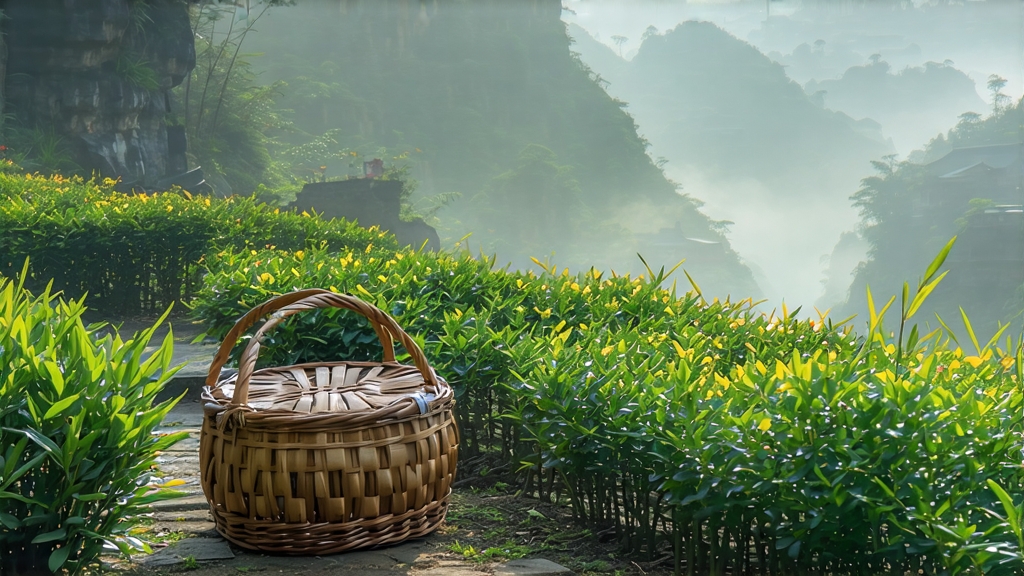
Tucked high above the Sichuan basin, where perpetual cloud veils the Min River gorge, lies Meng Ding Mountain, the cradle of the world’s oldest recorded tea garden. It was here, in the mist-cooled bamboo forests of Ya’an, that Buddhist monks first coaxed the down-covered buds of Camellia sinensis into a luminous yellow liquor more than twelve centuries ago. The finished leaf—known in the Tang dynasty as “Huang Ya” and later celebrated in Song-era scrolls as “Meng Ding Huang Ya”—became one of the first teas ever reserved exclusively for the emperor, carried 1,800 km north along the ancient Tea-Horse Road in yak-skin satchels sealed with wax and prayer flags. Today the same cultivar, grafted onto venerable seed-stock trees that still push through limestone crevices at 1,450 m, produces a harvest so small that an entire spring yields less than 800 kg, most of it pre-sold to collectors in Beijing and Tokyo before the Qingming festival.
Meng Ding Huang Ya is not a generic “yellow tea”; it is the archetype from which all later yellow styles—Huoshan Huang Ya, Junshan Yinzhen, Beigang Maojian—borrowed the critical “sealed yellowing” step. Within China’s official 1958 tea taxonomy it sits alone in Category 6, Group 1, Type 1, a legal recognition of its genetic and historical primacy. Locals divide the leaf into three micro-grades that appear almost identical to outsiders yet differ dramatically in cup:
- “Que-she” (sparrow-tongue), the first two leaves and a bud picked before March 20, when the bud still curves like a bird’s tongue and carries 9.3 % theanine.
- “Chen-feng” (dawn peak), plucked during the five-day window after spring equinox when the bud straightens and the leaf tip blushes bronze.
- “Yu-hou” (rain after), a late harvest immediately following the first spring rain, when the leaf broadens and the stem turns jade-green, yielding a lighter, more floral cup prized in Chengdu teahouses for afternoon service.
The craft begins the moment the basket touches the monk-built stone terrace. Leaves are spread no thicker than two centimeters on woven bamboo trays and withered for precisely 50 minutes in mountain shade that never exceeds 18 °C; direct sun is forbidden, lest the leaf oxidize toward green tea. A 3-minute “sha-qing” (kill-green) follows in a wok heated to 140 °C by locally harvested bamboo culms whose natural oils impart a faint coconut note. While still at 60 °C the leaves are wrapped, still hot, in thick yellow cotton cloth the size of a pillowcase; this is the first “men-huang” (sealed yellowing), a 48-hour anaerobic rest during which chlorophyll degrades into pheophytin and the leaf edges turn the color of old parchment. The bundle is opened only once, at 24 hours, to release trapped CO₂, then re-wrapped and left under the monks’ sleeping quarters where the constant 22 °C body heat of resident novices supplies the micro-fermentation. After the second men-huang the leaf is returned to the wok for a 45-second “ti-xiang” (aroma lift) at 80 °C, then hand-rolled into needle shapes using a technique called “long tiao” that mimics the motion of drawing a silk thread through jade. A final low-temperature bake over charcoal made from wild pear wood reduces moisture to 5 % while locking in a chestnut-honey fragrance that can survive ten years of aging.
To brew Meng Ding Huang Ya you need patience more than equipment. A 120 ml gaiwan of unglazed Yixing zi-sha (purple clay) seasoned only with yellow teas is ideal, but a simple glass tumbler works if you respect the leaf. Use 3 g—about thirty buds—for every 100 ml of water at 85 °C; boiling water scalds the down and releases bitter quercetin. Rinse once, discard immediately, then steep 45 seconds. The first infusion should be the color of chrysanthemum macerated in morning light, releasing an aroma that moves through four distinct waves: wet bamboo, steamed maize, alpine orchid, and finally a trace of Sichuan pepper that t